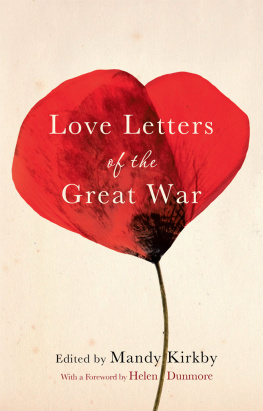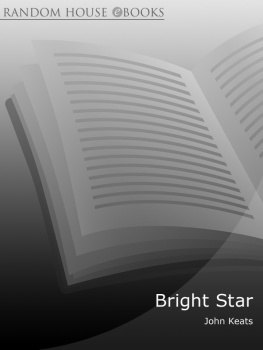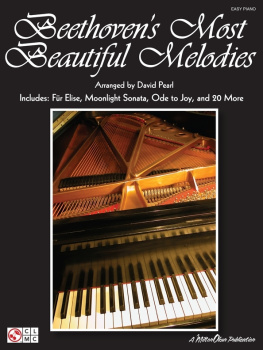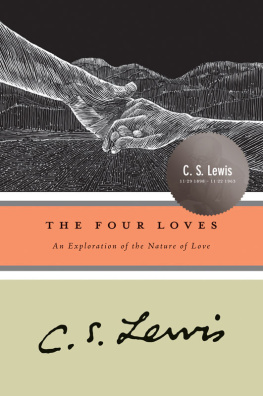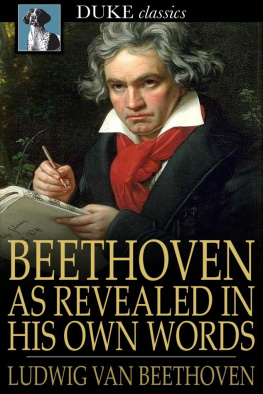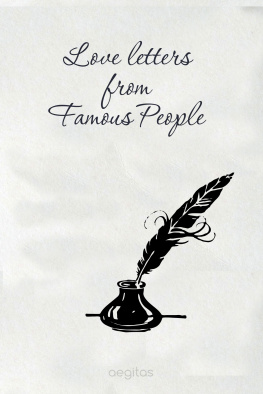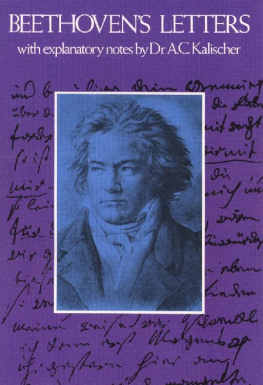Love
Letters
o f
Great
Men
*~*~*
Vol. 1
John C. Kirkland
Love Letters of Great Men
Volume One
Copyright 2008 John C. Kirkland
All rights reserved
www.llogm.com
T his book , or any part thereof not in the public domain, may not be reproduced in any form or by any means , electronic or mechanical , including photocopying , recording, or by any information storage or retrieval system now known or hereafter devised , except in accordance with legally permissible fair use, without permission in writing from the copyright holder.
Library of Congress C ataloging-in- P ublicat ion data available upon request
Love letters of great men , volume 1 / compilation and commentary by John C. Kirkland
1. Love-letters. I. Title. Love letters of great men , volume 1 . II. Kirkland, John C.
First edition
Published in the United States of America
For her
Table of Contents
List of Illustrations
Foreword
The Poet Warrior
First Century
Ovid
Pliny the Younger
Sixteenth Century
Henry VIII
Henry the Great
Seventeenth Century
Sir Walter Raleigh
Oliver Cromwell
Eighteenth Century
Voltaire
George Washington
Goethe
Robert Burns
Mozart
Napol on
Early Nineteenth Century
Beethoven
Lord Byron
Keats
Victor Hugo
Franz Liszt
Nathaniel Hawthorne
Shelley
Robert Browning
Gustave Flaubert
Edgar Allen Poe
Late Nineteenth Century
Leo Tolstoy
Balzac
Robert Schumann
Maj. Sullivan Ballou
Mark Twain
Van Gogh
Lewis Carroll
Pierre Curie
George Bernard Shaw
Twentie th Century
Jack London
Admiral Peary
Kafka
Woodrow Wilson
Afterword
Whats Past is Prologue
Index
~ ~
List of Illustrations
St. George and the Dragon (1890)
Ovid, from the Book of Chronicles (1493)
King Henry VIII, portrait (1540)
Sir Walter Raleigh, portrait (1585)
Dictionnaire philosophique by Voltaire (1764)
Goethe , portrait (1788)
Mozart, family portrait (1764)
Napol on Crossing the St. Bernard Pass (1805)
Beethoven , portrait (1803)
Lord Byron, portrait (1809)
Les Misrables by Victor Hugo (1862)
The Scarlet Letter by Nathaniel Hawthorne (1860)
Frankenstein by Mary Shelley ( 1831 )
Pit and the Pendulum by Edgar Allan Poe ( 1919 )
Rober t and Clara Schumann, portrait (1847)
The Starry Night by Vincent van Gogh (1889)
Photographic plate by Lewis Carroll (1873)
Pierre and Marie Curie, photograph (1905)
Jack London, photograph (1914)
Admiral Peary, photograph ( 1910 )
War Message by Woodrow Wilson (1917)
Connla and the Fairy Maiden (1909)
~ ~
St. George and the Dragon by
Gustave Moreau (1890)
~ ~
Forew o rd
The Poet Warrior
For millennia t he poet warrior has been the archetype of the romantic hero . Powerful but sensitive, dangerous but caring, brilliant but misunderstood. From Ulysses to Indiana Jones, every man wants to be him and every woman wants to be with him. Despite the prevalence of this ideal, many belie ve the poet warrior exists only in the realm of fiction . In truth, as you may glean from reading the compilation of love letters gathered here, some of history s greatest leaders have shownat least to those they care the most aboutthat they too have the soul of a poet.
Real men are much more astonishing than avatars. Napolon is universally known as a superb military tactician, but he also led the archaeological expedition that discovered the ancient Rosetta Stone. The brilliant romantic poet, Lord Byron, commanded the Greek revolutionary forces against the Ottoman Turks. Goethe not only wrote the classic Faust , he discovered the intermaxillary bone in the human jaw that inspired Darwin s theory of evolution . The poet warrior is everywhere.
S ince before the watchers of the sky created Stonehenge, Khufu conceived the Great Pyramid, or the first farmer toiled in the Cide Fields, closer to the time glacial ice still covered their lands than to today, the fianna of ire lived as hunters and warriors , men who could be called upon for the protection of the kingdom in time of need . Young nobility who had yet to inherit their land or fortune , these early Gaelic poets survive d by hunting for food and furs. Though forced by circumstance to live mostly outside society, they mingled comfortably among aristocrats. One who demonstrated sufficient skill with words , by the telling of tales of honor and glory, recitation of poems of love and loss, or singing of odes of leitmotiv and med it a t i on , may be invited to face the trials and prove his worth to join this druidic coalition of clans.
H air ceremonially braided he would run a gauntlet of his fellows through the thick forest, a single twig snapping under foot or mere hair out of place resulting in failure. Buried to his waist in peat with only a wooden shield to protect him, the slightest drop of blood caused by any of the nine spears thrust upon him meaning he would never have a chance to help defend the defenseless in battle. At least, that s what they told the ladies that night. Their ancient motto has been adopted by the special forces of the Army Ranger Wing, the Republic of Ireland s premier hostage rescue unit:
Glaine r gcro (purity of our hearts)
Neart r ngag (strength of our limbs)
Beart de rir r mbriathar (deeds to match our words)
History is replete with examples of those who lead by example, with wisdom, courage and love, guided by reflection and empathy, using their minds to accomplish what their hearts know to be true. Tolstoy ended the lives of many men at the end of a cannon or the point of a sword, before writing the words that inspired a generation of nonviolent resistance that changed the world. The legendary stories of the garden of Gethsemane may be the apogee of the poet warriorsimultaneously the highest conceivable levels of both courage and compassion.
Like the Tao, the true poet warrior is subtle and quiescent, circumve nting attempts to force his way; simultaneously passionate and indifferent, nurturing and giving wholly of himself to each who comes across his path. Like a first growth Bordeaux he is deep and complex, rich and balanced, dedicated to both the intellect and the corpus, the field of study and the field of battle. He exemplifies t he way of the warrior, from t he Analects of Confucius and the Bushido code of the Samurai, to the medieval knightly virtues of chivalry, honor and courtly love.
Sir Walter Raleigh gladly suffered the Tower rather than be separated from his true love, and chose to let his headrather than his honorbe separated from his corporal form. Such greatness often comes with a price, and real men are infinitely more involuted than their fictional counterparts. Greatness may be good or evil, but is more often a combination of both, at least in some measure. Great men and great loves are not caricatures; they are complex, complicated and, often, conflicted. Henry VIII freely professed his love for his wives, but that did not stop him from sometimes taking their lives.
Victory and failure, forgiveness and betrayal, masterwork and bagatelle, i t is each poet warrior s individual journey, ba ttles and scars that provide a true glimpse into greatness.
Next page

